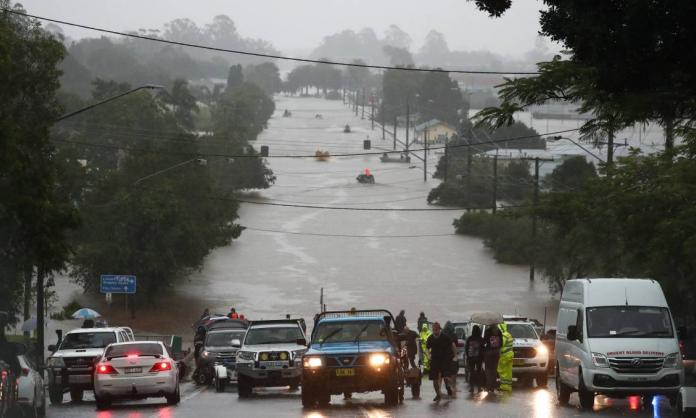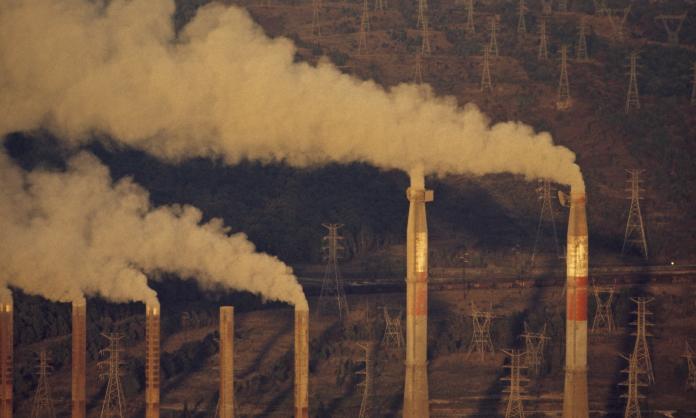Hundreds of people in Lismore woke up on Monday morning trapped in their houses. Most of them went to sleep with the reassurance that, despite flood warnings, their houses had never been reached by flood water before—including during the “big floods” of 1954, 1974 and 2017. But after the Wilsons River broke the town’s levee wall, it kept rising far beyond what had been projected. An evacuation order was issued at 1am, while most people were sleeping. They woke to water in their houses—which are mostly on stilts—climbed into attics and onto roofs, and waited.
The State Emergency Service was inundated with calls that almost instantly exceeded the service’s capacity. According to the town’s mayor, Steve Krieg, Lismore had access to only two SES boats. Desperate people were forced to turn to social media for help. One man posted that his mother who couldn’t swim was trapped inside her second story flat, inundated with rising water. Later, he told Red Flag that she waited in her house for seven hours before being rescued by neighbours, who brought her to the roof of the nearby pub. She waited on the roof of the pub for another two hours before being rescued by the SES.
Another woman told Red Flag she climbed into her roof cavity with her 10-month-old baby, her partner and her two dogs while water rose through their house. They stayed there for eight hours before being rescued by a friend. They were lucky—some 400 people spent a second night trapped.
Most of the town is now unliveable and thousands of people are likely homeless. At the time of writing, nine people are unaccounted for, and two confirmed dead. Meanwhile, Queensland is also reeling. Eight people are confirmed dead in the state, while the flood water is flowing into more towns and the weather system is inundating more communities as it moves south. Buildings have disappeared, roads have been washed away in landslides, bridges have collapsed, and thousands of people have had their lives upended. Whole communities are holding their breath as they wait to discover the true level of human life lost. They deserve answers about what, and who, caused this catastrophe.
Firstly, there is the question of climate change and extreme weather events. Because it is located in a floodplain, Lismore is naturally flood prone. But it has never experienced a flood like this. The Bureau of Meteorology's Jackson Browne called it “biblical”, and said “there is nothing in the record books like it”. New South Wales’ Minister for Emergency Services, Steph Cook, said it was “a natural disaster of unprecedented proportions for this region”. But when the word unprecedented is used as regularly to describe weather events as it has been in Australia over the last few years, there is increasing reason to question exactly how “natural” these disasters are.
Lismore’s levee, which was erected in the early 2000s, was broken for the first time in the 2017 flood, which was called a “once in a lifetime event”. Yet here we are five years later, with a new flood record that has smashed its predecessor by more than two metres. And more minor (in comparison) floods occurred in Lismore that were bad enough for natural disaster classification in December 2020 and March 2021.
Climate change is making these events more extreme and more frequent – and the pattern in the Northern Rivers goes beyond floods. During the Black Summer bushfires in 2019, when the area was experiencing a long drought, bushfires burned for weeks in places with no recorded history of fires. The Nightcap National Park is meant to be one of the wettest places in the country, but the long dry spell turned it into bushfire terrain. It’s a forest that pre-dates the Australian continent, but will it survive the change inflicted on the climate by capitalism and fossil fuels? The Tuntable community was one of the areas evacuated during that bushfire. Now, parts of Tuntable Road have disappeared—washed away in landslides caused by the flood.
The pace of global warming caused by human activity, compared with the much slower progression of non-human related climate patterns, makes it difficult to prove a direct causal link between recent weather events and human-induced climate change. But as Professor Mark Howden, who is the vice-chair of the Intergovernmental Panel on Climate Change working group which recently released a report about the likely effects of current warming and director of the ANU Institute for Climate, Energy and Disaster Solutions, recently told the Guardian, “It’s more likely you’re going to see [these sorts of events] in the future with climate change because of the warmer atmosphere, and the ability to hold more moisture in the warmer atmosphere”. He also said that rainfall will be heavier, “The frequency may not change, but the strength of [storms] will change and that will increase the variability of climate in Australia, particularly in the north-east and down through the south-east”. This is what the spiralling process of climate destruction inflicted by governments and corporations across the world will mean: an erratic mix of unprecedented floods, fires, droughts, heatwaves and more.
Secondly, while politicians drive us down a path of climate destruction, emergency services and mitigation efforts remain under-resourced and volunteer-focused. Like Australia’s firefighting services, the SES is an almost entirely volunteer-run service. The inadequate resources at the disposal of SES volunteers in Lismore—two boats with an entire town underwater and hundreds if not thousands of people in need of urgent rescue—is nothing short of criminal.
Governments expect volunteers to risk their lives at the front lines of the climate catastrophe, while the fossil fuel companies that are responsible for these disasters enjoy generous government subsidies. Whether it’s the firefighters forced into the black summer fires or the SES volunteers entering submerged towns, they are expected to deal with these disasters in their own time and with woefully inadequate resources.
The promises made to flood-proof Lismore in 2017 and 2019 by then-premier Gladys Berijiklian and then-prime minister Malcolm Turnbull, and again in 2020 by prime minister Scott Morrison have come to nothing. If state and federal leaders were serious about tackling the issue, they would immediately begin to convert the country’s volunteer emergency services to the well-funded, permanent systems they should be. Money would be thrown at efforts to stop future floods, but Lismore—Australia’s most flood-prone city—was mysteriously left off a priority funding list late last year that instead allocated resources to less-affected surrounding areas.
The $1,000 disaster payment announced amid the current crisis will do little for those who have lost everything. Meanwhile, defence minister Peter Dutton has set up a gofundme for flood relief in Queensland’s Pine River, apparently seeing the recovery as something that should be funded by private citizens, not his government. That’s the same minister who just allocated $50 billion annually to the defence budget.
It’s heartening to see the way that ordinary people step into the void. While the SES in Lismore had only two boats at its disposal, dozens of untrained locals rescued large numbers of people. Mick Cheffins, who works as a cleaner, was one of them. “I picked up about 30 people from the roofs,” he said. “The SES were overwhelmed, so we’d run into an SES boat and they’d tell us where to go—but I smashed my windscreen and broke the propeller by running into so many submerged cars”.
Anne-Marie, Mick’s wife, is an emergency department nurse practitioner at Lismore Base Hospital, which is over capacity after taking in evacuated aged care residents and patients who developed hypothermia waiting to be rescued. The water covering Lismore stretches to the bottom of the hospital precinct, meaning Anne-Marie hasn’t been able to get to work. She said she hoped the water would recede enough that she could use the damaged boat to show up to her shift tomorrow. Meanwhile, a group of immigrant abattoir workers stepped in to evacuate an aged care home when its residents became trapped.
The stories of community self-help that emerge with each extreme weather event show how much ordinary people care about each other. For many, the economic and emotional cost of this and other disasters will be long felt. But for the wealthy, it will be a very different story. In the event they are affected, they will have the resources to recover quickly—to rebuild destroyed houses, replace ruined possessions and the pay the high insurance premiums that will follow.
For the wealthy and those who run Australian capitalism, business as usual matters more than a few destroyed lives. That means keeping coal exports going, keeping the fossil fuel companies in business and keeping budgets for social and emergency services that don’t make huge profits to a minimum. These are the people who must be made to answer for the environmental disasters we are facing now and will face more of in the future.










